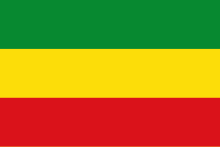Amhara nationalism is a form of ethnic nationalism and political movement that advocates the interests of Amhara people in Ethiopia, asserting Amhara is a single secular nation with ethno-cultural identity. The movement broadly emerged as counter discourse of the modern Ethiopian politics, which is based on national oppression thesis. [1] [2] [3]

Sometimes, this type of nationalism associated with pan- Ethiopian nationalism which is a form of civic nationalism. Some see it as a symbol of patriotism over Ethiopians while other portray this nationalism as maintaining Amhara political and territorial identity. For example, Amhara youth tend to related with ethnic and political identity compared to older generation who are more likely express pan-Ethiopian stance. [6]
Historical perspectives
Historically, Amhara nationalism was correlated with Ethiopian nationalism, which supports civic nationalism among Ethiopian ethnic group. [7] In early 1992, All Amhara People’s Organization (AAPO) was founded by Professor Asrat Woldeyes to represent Amhara as one identity. The Amhara National Democratic Movement (ANDM) similarly followed such stance after formed by Amharan prisoner of wars with the help of TPLF-dominated EPRDF coalition before the fall of the Derg — became an official Amhara political party in Ethiopia. However, only Amhara peasants remained the last class without any formal political organization as both AAPO and ANDM represented the urban population of Amhara, claiming they stand for Amhara sovereignty. AAPO instead spoke for Ethiopian nationalism without leaving the notion of Amhara nationalism in both rural and urban population that resulted in the formation of All Ethiopian Unity Party. [4]
The Amhara peasants were subjected to defraud when they assist Amharas who were under attack by other ethnic group in the south, notably by the Arsi Oromos. They claim that "Amhara" was the descendant of Emperor Menelik II soldiers who conquered in the 19th century. As such, they are identified by the local peasants not only as landlords and administrators, but they are Orthodox Christians. [4]
Comparison with Ethiopian nationalism
The Amhara people often viewed by external observers as a symbol of Ethiopian patriotism and link with the Ethiopian nationalism. [8] In contrast, the ethnic federalist EPRDF viewed by Ethiopian nationalists including the Amhara nationalist and elites as "unpatriotic" or even treacherous. [9] [10] However, some Amhara nationalists claim they are democratic in ethnic federalism state due to they grant self-determination to minority group in the region, such as in Oromia and Agew Awi Zones. [11]
The Derg regime often portrayed as the continuation of Amhara imperial government despite Amharas were subjected to grave brutality. Taffara Deguefe, the President of the Commercial Bank of Ethiopia wrote a memoir titled The Tripping Stone in his prison cell that described the moment of discrimination against Amhara during the regime: [12]
The only ‘minorities’ who are scorned are the hopeless Amhara for their past privileges. They have to pay for it now in lost jobs and positions for their hateful identification to a past now seen as distasteful to the military junta.
The Welkait controversy is the source of Amhara nationalism since 2016. [13] During the first months of Tigray War, Amhara forces recaptured the town. [14] The Fano movement is an ethno-nationalist protest movement that claims to represent Amhara people, which slightly gained widespread support in Ethiopia. They are closely tie to the notion of "Ethiopianness" with its tenet relates with the presence of the Ethiopian Orthodox Tewahedo Church, claiming that Amhara is suffering from government persecution and perpetuating genocidal intent. [15]
See also
References
- ^ Tazebew, Tezera (April 2021). "Amhara nationalism: The empire strikes back". African Affairs. 120 (479): 297–313. doi: 10.1093/afraf/adaa029. Retrieved 2023-11-12.
- ^ Sew, Mistir (2021-06-07). "Amhara nationalism at the polls in Ethiopia". Ethiopia Insight. Retrieved 2023-11-12.
- ^ "Does Amhara nationalism have a unique DNA?". Borkena Ethiopian News. 2023-10-17. Retrieved 2023-11-12.
- ^ a b c "The Two-Faced Amhara Identity". 11 November 2023.
- ^ Tefera, Goshu Wolde; Castro, A. Peter (2016-11-01). "Flag Politics in Ethiopia and the Ethio-American Diaspora". Journal of International and Global Studies. 8 (1): 1–21.
- ^ "The Birth of Amhara Nationalism: Causes, Aspirations, and Potential Impacts". Addis Standard. 12 November 2023.
- ^ Shiferaw Chanie, Bantanyehu; Ishiyama, John (October 2021). "Political Transition and the Rise of Amhara Nationalism in Ethiopia". Journal of Asian and African Studies. 56 (5): 1036–1050. doi: 10.1177/00219096211015322. ISSN 0021-9096.
- ^ "Ethiopia: Defining Amhara nationalism for a better country". The Africa Report.com. Retrieved 2023-11-11.
- ^ Gebrewold, Belachew (April 2009). "Ethiopian Nationalism: An Ideology to Transcend All Odds". Africa Spectrum. 44 (1): 79–97. doi: 10.1177/000203970904400106. ISSN 0002-0397.
- ^ Michael, Mackonen (November 2008). "Who is Amhara?". African Identities. 6 (4): 393–404. doi: 10.1080/14725840802417943. ISSN 1472-5843.
- ^ Borago, Teshome M. (2018-12-10). "What is the point in Amhara nationalism?". Ethiopia Insight. Retrieved 2023-11-11.
- ^ Moges, Zola (2020-09-01). "Shaping Amhara nationalism for a better Ethiopia". Ethiopia Insight. Retrieved 2023-11-11.
- ^ Account (2023-10-17). "Does Amhara nationalism have a unique DNA?". Borkena Ethiopian News. Retrieved 2023-11-12.
- ^ Endeshaw, Dawit (2023-01-14). "Amhara forces withdraw from parts of Ethiopia's Tigray region, army says". Reuters. Retrieved 2023-11-12.
- ^ "Ethiopia: understanding the Fano and the fate of Amhara". The Africa Report.com. Retrieved 2023-11-12.